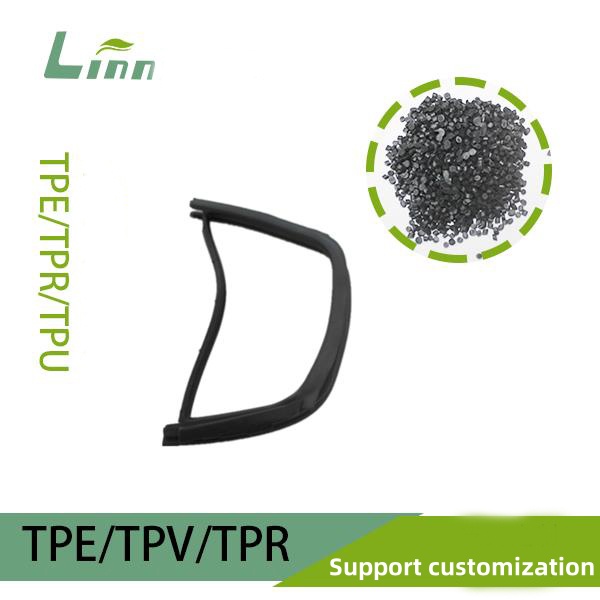With over fifteen years in materials science, I’ve tackled flow marks—wavy streaks or ripples—on TPE (Thermoplastic Elastomer) parts like grips, seals, and cases. These surface defects can ruin aesthetics and signal process issues. This guide shares my proven fixes, from quick tweaks to technical solutions, to help you achieve smooth, streak-free TPE surfaces.

What Are Flow Marks?
Flow marks are visible lines or ripples on TPE parts, caused by uneven material flow during molding or extrusion. They affect appearance and may hint at performance issues, especially in soft, low-viscosity TPEs used in consumer, automotive, or medical products.
Causes of Flow Marks
Uneven Flow: TPE’s low viscosity causes turbulent flow, creating streaks.
Mold Temperature: Too cold (<104°F/40°C) or hot molds disrupt flow.
Injection Speed/Pressure: Fast or slow injection causes jetting or hesitation.
Mold Quality: Smooth or unvented molds trap air, causing marks.
Contamination: Moisture or dust in TPE disrupts flow.
Formulation: High fillers or oils alter viscosity.
Design: Thin walls or sharp corners restrict flow.
Solutions to Eliminate Flow Marks
1. Optimize Mold Temperature
How: Set molds to 104°F-140°F (40°C-60°C) for smooth flow (ASTM D3835).
Tips: Use 122°F (50°C) for SEBS TPE; monitor with thermocouples.
Pros: High impact, low cost.
Cons: Needs precise control.

2. Adjust Injection Speed/Pressure
How: Use 20-50 mm/s speed, 500-1200 psi pressure, with a two-stage profile.
Tips: Keep melt temps at 356°F-410°F (180°C-210°C) to avoid shear heating.
Pros: Scalable, effective.
Cons: Requires calibration.
3. Improve Mold Design/Venting
How: Add 0.001-0.002 inch vents, texture molds (Ra 0.8-1.6 µm), widen gates (ISO 294-1).
Tips: Vent at flow endpoints; use micro-vents for corners.
Pros: Long-term fix.
Cons: High mold cost.
4. Ensure Material Purity
How: Dry TPE at 158°F-176°F (70°C-80°C) for 2-4 hours (<0.02% moisture, ASTM D6869).
Tips: Store with desiccants, use virgin TPE.
Pros: Prevents multiple defects.
Cons: Drying time, equipment.
5. Fine-Tune TPE Formulation
How: Reduce fillers to <10%, use low-viscosity oils or flow modifiers (ASTM D1238).
Tips: Request flow test data from suppliers.
Pros: Tailored performance.
Cons: Cost, supplier dependency.

6. Post-Processing Treatments
How: Use flame treatment, plasma polishing, or matte coatings to hide marks (ASTM D3359).
Tips: Test coating adhesion first.
Pros: Salvages parts.
Cons: Alters feel, adds steps.
7. Optimize Part Design
How: Use 1-2 mm walls, >0.5 mm radii, place gates at thick sections.
Tips: Run mold flow simulation to spot issues.
Pros: Prevents defects.
Cons: Redesign cost.
Comparison Table
| Method | Effectiveness | Cost | Best For | Challenges |
|---|---|---|---|---|
| Mold Temperature | High | Low | All parts | Precise control |
| Injection Settings | High | Low | High-volume | Calibration |
| Mold Design | Very High | High | Complex parts | Mold cost |
| Material Purity | Medium-High | Medium | Medical uses | Prep time |
| TPE Formulation | High | High | Premium parts | Cost |
| Post-Processing | Medium | Medium | Aesthetic fixes | Alters feel |
| Part Design | High | Medium | Thin parts | Redesign |
Practical Applications
Yoga Mats: Mold temp and vents cleared ripples.
Phone Cases: Slower injection, thicker walls removed streaks.
Medical Grips: Pre-drying ensured USP Class VI compliance.
Car Seals: Custom TPE, wide gates cut marks.
Wearable Straps: Coatings hid minor defects.

Tips for Success
Use mold flow software to predict issues.
Verify batch purity with suppliers.
Test small batches to isolate variables.
Clean molds with isopropyl alcohol.
Train operators to spot streaks early.
Conclusion
Eliminate TPE flow marks with optimized molds, processing, materials, and design. These solutions ensure smooth, professional parts for any application.





